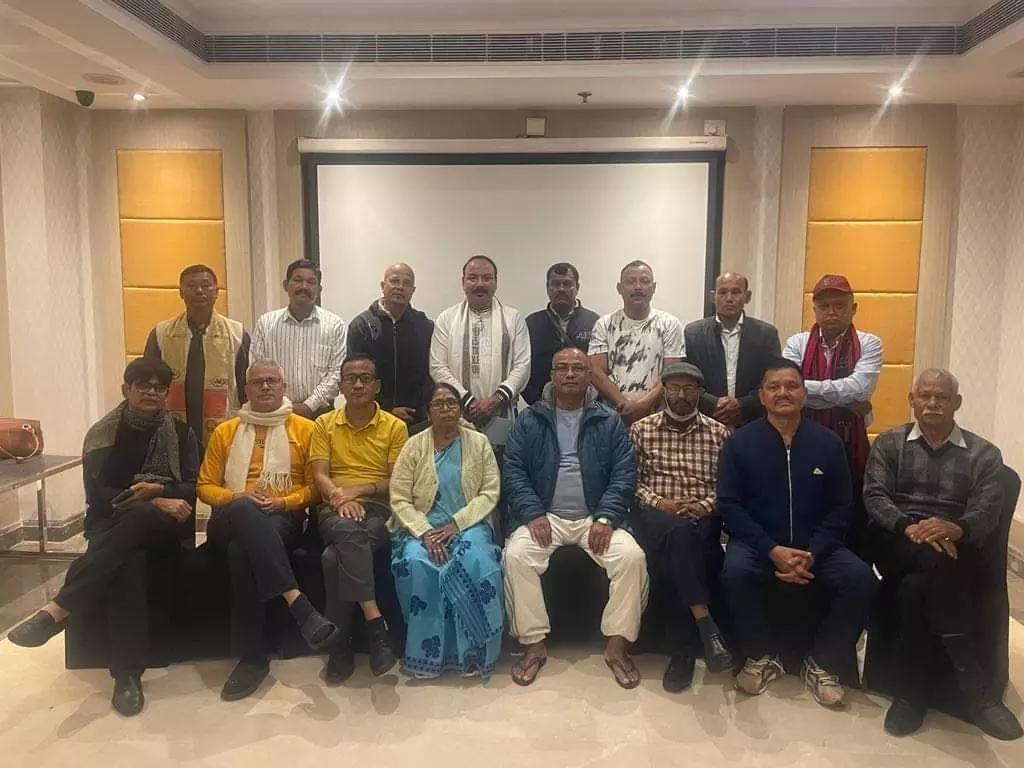
The 16-member ULFA pro-talks faction poses for a photo in New Delhi. Photo: The Federal
BJP hard-sells peace deal with ULFA as ‘historic’ move, but concerns remain
Even though the agreement promises to dismantle the armed group within a month, permanent peace is a far cry until the Paresh Barua-led ULFA (Independent) faction is brought around

The Centre on Friday (December 29) signed a peace agreement with the pro-talk faction of the United Liberation Front of Asom (ULFA) capping over a decade-long negotiation to end the insurgency in Assam. The peace process began during the Congress regime in 2011.
As expected, the BJP governments both in New Delhi and Dispur tried to hard sell the deal as a major breakthrough in establishing permanent peace in the state by addressing core identity issues that beset the state for years and led to the formation of the ULFA on April 7, 1979.
Can permanent peace be achieved?
As per the agreement, the armed group will be dismantled within a month with surrendering of arms to join the mainstream. Both the Union Home Minister Amit Shah and Assam Chief Minister Himanta Biswa Sarma described the agreement as “historic”.
They said the agreement would help establish permanent peace in the state, a claim many would take with a pinch of salt.
The ULFA (Independent) faction led by Paresh Baruah is still waging armed insurgency, demanding “sovereignty.”
The group of late started flexing muscle much to the concern of the security establishment of the state.
A permanent peace would be a far cry until Baruah and his faction comes over ground.
The memorandum of settlement signed with a 16-member ULFA pro-talk delegation headed by its chairman Arabinda Rajkhowa may now put Baruah under pressure to follow the suit.
“This agreement is a step toward bringing Paresh Baruah to the negotiating table,” Sarma maintained.
Demands and promises
To put pressure on Baruah to come to the mainstream, the peace accord needed to be implemented in letter and spirit, and should fulfil the aspirations of the people that forced many misguided youth to take up guns.
“The accord will be fulfilled to the point of commas and full stops in a time-bound manner. A committee will be formed to ensure that,” the home minister assured.
One of the core demands of the outfit to grant Scheduled Tribe (ST) status to the state’s six communities— Moran, Muttock, Tai-Ahom, Koch-Rajbongshi, Sootea, and Tea Tribes — has not been addressed in this peace deal. These communities are listed as OBCs in the state.
The granting of the ST status was also a poll-promise of the BJP. Sarma said the demand would be taken up separately.
There is also no clarity as to how another demand of the outfit for providing political safeguards to the indigenous communities will be addressed by the peace deal.
“Benefit for indigenous communities through delimitation (by reserving 94 seats),” the ULFA said in a statement.
Safeguards in peace deal
Sarma claimed that the recent delimitation exercise carried out by the Election Commission of India in the state has already safeguarded the interest of the indigenous communities.
This peace deal has a provision that ensures that even the same safeguard would remain unchanged by following the same methodology even in future delimitation process, Sarma told the media.
The deal further stressed on the need to review the NRC without delving in details on the issue as it is a sub-judice matter, the chief minister said after inking of the peace deal.
A financial package of ₹1.5 lakh crore is another major highlight of the agreement, fine print of which is not yet made available.
Why Tai-Ahom support is good news for BJP
The agreement is seen as a major political boost for the BJP as the ageing top guns of the ULFA that constitutes the pro-talk faction still have some pockets of support in Upper Assam, the administrative division comprising 10 districts.
The region, of late, is witnessing a churn following delimitation of Lok Sabha and assembly constituencies in the state to the extent of an influential Tai-Ahom organisation reviving an old demand for a separate Ahom state by carving out the upper, central, and northern parts of present-day Assam.
The Ahom-land demand, which was first raised in 1967, got a fresh momentum after the ECI’s proposed delimitation draft, published in June, allegedly reduced Tai-Ahom-dominated assembly seats from nine to three.
To add to the BJP’s discomfort in the Ahom heartland of Upper Assam, all the top opposition leaders of the state are from the region. The Congress troika of PCC president Bhupen Borah, CLP leader Debabrata Saikia (son of former chief minister Hiteswar Saikia) and the party’s deputy leader in the Lok Sabha Gaurav Gogoi (son of another former chief minister Tarun Gogoi), Assam Jaitya Parishad chief Lurinjyoti Gogoi and Raaijor Dal president Akhil Gogoi all are from the Upper Assam.
The BJP’s tallest leader from the region Sarbananda Sonowal has been shunted out from the state to the Centre.
How the Tai-Ahom groups react to the endorsement given to the delimitation process by the ULFA’s peace deal remains to be seen.
The presence of several civil society groups representing various ethnic communities, including that of Tai Ahom, in the signing agreement was, however, a sign of soothing of frail nerves.
Key highlights of the deal
1. Lack of agreement on ST status.
2. Empowerment of indigenous groups in 94 out of 126 assembly seats via delimitation.
3. Formation of a committee to assess OBC reservation in urban local bodies and panchayats.
4. Increased scrutiny of the voter registration process to prevent illegal registrations.
5. Proposed legislation for definitive land titles, potentially restricting non-indigenous land purchases.
6. Safeguarding agricultural land.
7. Plans to establish Cultural Academies and Research Centers.

